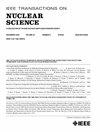Improved Performance of Energy-Selective Gamma-Ray Imaging System Based on Image Restoration
IF 1.9
3区 工程技术
Q3 ENGINEERING, ELECTRICAL & ELECTRONIC
引用次数: 0
Abstract
The application of intense current transient pulse radiation fields encompasses a wide range of fields, from scientific research to industrial application. The generation and application of this radiation have become an important direction of current research. Ray detection technology (such as neutron detection, gamma ray detection, etc.) plays a key role in understanding the working state, physical mechanism, and process of different pulse radiation devices. With a new energy-selective gamma-ray imaging technique based on a magnetic lens, the energy and spatial information of pulsed gamma rays can be obtained simultaneously. However, due to the limitations of angle and energy dispersion, the detection efficiency and spatial resolution of the system cannot be simultaneously optimized, which limits its practical application. To overcome this limitation, a method combining system optimization and imaging restoration is proposed to improve the performance of energy-selective gamma-ray imaging. In this article, the effect of beam-limiting hole size on detection efficiency and spatial resolution in an energy-selective gamma-ray imaging system is analyzed. The imaging dataset of the energy-selective gamma-ray imaging system is constructed using a Geant4 simulation, and a deblurring generative adversarial network (GAN) based on a weighted bidirectional feature pyramid is developed. The results demonstrate that by selecting Dx =60 mm and Dy =30 mm as the new beam-limiting hole size parameters, the detection efficiency of the imaging system can be improved by approximately four times, and the spatial resolution performance of 1.2 mm in the x-direction and 2 mm in the y-direction can be achieved by the proposed algorithm. Furthermore, the reliability of the proposed algorithm is substantiated by experimental verification.基于图像恢复的能量选择性伽马射线成像系统性能改进
强电流瞬态脉冲辐射场的应用涵盖了从科学研究到工业应用的广泛领域。这种辐射的产生和应用已成为当前研究的一个重要方向。射线探测技术(如中子探测、伽马射线探测等)对了解不同脉冲辐射装置的工作状态、物理机理和过程起着关键作用。采用一种基于磁透镜的新型能量选择性伽马射线成像技术,可以同时获得脉冲伽马射线的能量和空间信息。然而,由于角度和能量色散的限制,系统的检测效率和空间分辨率无法同时优化,限制了其实际应用。为了克服这一局限性,提出了一种结合系统优化和成像恢复的方法来提高能量选择性伽马射线成像的性能。本文分析了束流限制孔尺寸对能量选择性伽玛射线成像系统探测效率和空间分辨率的影响。利用Geant4仿真构建了能量选择性伽玛射线成像系统的成像数据集,开发了基于加权双向特征金字塔的去模糊生成对抗网络(GAN)。结果表明,选择Dx =60 mm和Dy =30 mm作为新的限束孔尺寸参数,可以将成像系统的检测效率提高约4倍,并且可以实现x方向1.2 mm和y方向2 mm的空间分辨率性能。实验验证了该算法的可靠性。
本文章由计算机程序翻译,如有差异,请以英文原文为准。
求助全文
约1分钟内获得全文
求助全文
来源期刊

IEEE Transactions on Nuclear Science
工程技术-工程:电子与电气
CiteScore
3.70
自引率
27.80%
发文量
314
审稿时长
6.2 months
期刊介绍:
The IEEE Transactions on Nuclear Science is a publication of the IEEE Nuclear and Plasma Sciences Society. It is viewed as the primary source of technical information in many of the areas it covers. As judged by JCR impact factor, TNS consistently ranks in the top five journals in the category of Nuclear Science & Technology. It has one of the higher immediacy indices, indicating that the information it publishes is viewed as timely, and has a relatively long citation half-life, indicating that the published information also is viewed as valuable for a number of years.
The IEEE Transactions on Nuclear Science is published bimonthly. Its scope includes all aspects of the theory and application of nuclear science and engineering. It focuses on instrumentation for the detection and measurement of ionizing radiation; particle accelerators and their controls; nuclear medicine and its application; effects of radiation on materials, components, and systems; reactor instrumentation and controls; and measurement of radiation in space.
 求助内容:
求助内容: 应助结果提醒方式:
应助结果提醒方式:


